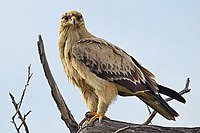
Photo from wikipedia
Tawny-bellied Seedeater (Sporophila hypoxantha) is an endangered (in Brazil) grassland dependent species, whose breeding success remains poorly known hampering conservation measures on its breeding grounds. Here we analyze the nest… Click to show full abstract
Tawny-bellied Seedeater (Sporophila hypoxantha) is an endangered (in Brazil) grassland dependent species, whose breeding success remains poorly known hampering conservation measures on its breeding grounds. Here we analyze the nest survival of the species in relation to temporal and environmental variables over three breeding seasons in hilly dry grasslands in southern Brazil. The apparent nest success was 40%, and MARK survival 20%. Predation was the main cause of failure, affecting 55% of the unsuccessful nests, followed by desertion, infestation by Philornis fly larvae, cattle trampling and burning. The productivity was 1.77 young per pair. Best models include time-specific factors (nest age and time of breeding season), reflected by a gradual reduction in nest survival over the nesting cycle, accompanied by an increase in temperature, subcutaneous larvae infestation, and predation. Nest site characteristics did not influence nest survival. Predation is more prevalent in the nestling rearing period than during incubation. This tendency may be caused by an increase in the activity in the nests, as is predicted by the Skutch hypothesis. The conclusion that time-specific factors influence nest survival more than ecological variables is important to plan on seasonally dependent conservation and management measures.
Journal Title: Anais da Academia Brasileira de Ciencias
Year Published: 2021
Link to full text (if available)
Share on Social Media: Sign Up to like & get
recommendations!